Boiler room diagram of a private house: principle of automation and equipment arrangement
In the absence of centralized heating, boilers take on the responsibility for heating the home.To accommodate such equipment, it is necessary to prepare a separate room, observing safety requirements and standards.
Agree, at first glance the task looks difficult. However, it is not. Knowing the basics of calculations, rules and design principles, you will be able to plan the room yourself. A typical boiler room diagram for a private house is developed taking into account the specific type of boiler and a list of additional equipment for the heating system.
We will help you understand the issue, describe the features of different boiler rooms, and outline the requirements and rules for their arrangement. Thematic videos clearly demonstrate examples of organizing premises for installing and piping boilers.
The content of the article:
Types of boiler houses for the private sector
The requirements for boiler houses are set out in SNiP with the nomenclature designation II-35-76.
Depending on the location of the room with heating equipment installed in it, boiler rooms can be classified into one of the following types:
- built-in;
- free-standing;
- attached.
The dimensions of the room allocated for the boiler room are selected based on the type of fuel, boiler design type.
When arranging a special boiler rooms difficult, there is another option - a mini-boiler room.
It is placed in a container assembled according to the principle of metal structures, which can be placed in the courtyard of the house. All that remains is to connect the mini-boiler room to communications.
The not very popular popularity of such modules is explained by their rather high cost. If there is a prospect of allocating space for a boiler room in the basement, you can buy the equipment separately. Then the heating system will cost much less.
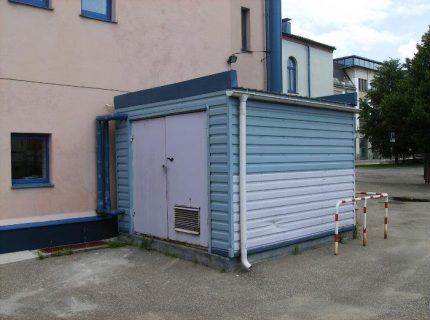
Home boiler room design
A significant part of the family budget is spent on heating the house.Therefore, at the design stage of the system, one should strive for its maximum optimization by performing an accurate calculation of the boiler room layout for suburban housing.
It will be necessary to calculate all options for the location of equipment, including the boiler, expansion tank, radiators, as well as taking into account the features of wiring and circulation.
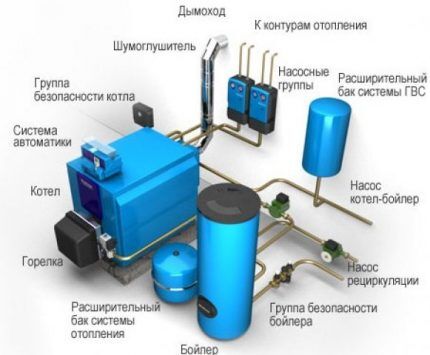
A well-designed schematic diagram of a boiler room should reflect all the elements and the pipeline connecting them.
The standard drawing includes: boilers, pumps - make-up, network, circulation, recirculation, tanks - condensation and storage, heat exchangers, fans, fuel supply and combustion devices, control panels, heat panels, water deaerator.
Possible circuit options
When drawing up a typical boiler room diagram, you can take as a basis one of two options for heating networks:
- open
- closed.
Installation open circuit less expensive, but more expensive during operation. The second option is more complex at the initial stage, but coolant leakage is practically reduced to zero, since the system is sealed. This scheme is used in most private houses.
Part closed system includes a boiler that provides hot coolant to both the heating system and the water heating circuit, a closed hot water supply pipeline.
The circulation of the coolant is carried out here forcibly by means of a pump.This allows, when installing pipes, without particularly worrying about slopes, to lay them in a way that is more convenient.
Requirements for the boiler room
There are 2 types of requirements put forward for a boiler room in a private house - general and specific, depending on the category of fuel used.
The first type of requirements include:
- A maximum of 2 boilers can be installed in one room, regardless of its area.
- When constructing and finishing a boiler room, it is unacceptable to use materials that do not meet fire safety requirements. For the construction of walls it is necessary to use brick or concrete blocks, and for finishing - plaster or tiles. The floor must have a concrete or metal covering.
- Ventilation and flue must be suitable for the installed equipment. Special requirements apply to ventilation when using gas-powered equipment.In any case, the air in the room must be circulated and renewed at least 3 times within 60 minutes.
- A prerequisite is the presence of a window and a door that opens outward. It is possible to have a second door leading to the utility room, but it must be done in accordance with fire safety conditions.
The area of the boiler room should be calculated based on the characteristics of the equipment that is planned to be installed and taking into account additional square meters for convenient maintenance.
There are a number of additional requirements for the premises and equipment of boiler rooms, depending on the decision made regarding the type of fuel.
Equipment for arranging a boiler room
Regardless of the type of fuel chosen, the technological scheme of any boiler house includes approximately the same required elements. The main place in the boiler room is the boiler. Here the coolant is heated and then flows through pipelines into the radiators.
If the house has a large area, then it is necessary collector installation. The element distributes the coolant between heating devices combined into separate groups. A hydraulic arrow is installed on the collector, which is a hollow pipe with pipes coming out of it.
Circulation pumps are installed on each circuit. The collector also includes a safety group, which includes a number of sensors, pressure gauges, and thermometers.
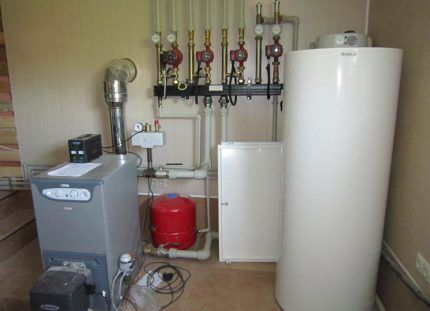
The expansion tank is also an integral element of the circuit. A private house cannot do without a water heater that provides its residents with hot water. A modern boiler room must be equipped with automation that controls all system parameters.
In any scheme there is a pipeline for supplying coolant, shut-off valves that allow you to adjust and configure the heating system.
A heating system necessarily has two interconnected systems:
- smoke removal — flue gas removal;
- ventilation — ensures high-quality combustion of fuel due to air flow.
Both systems are no less important than boiler equipment.
What is a “smart boiler”
To implement an automation scheme for a private boiler room, you need to invest additional funds. A simple thermostatic valve will cost very little, but programmable systems are many times more expensive.
Constant operation of a conventional boiler in one mode entails a large consumption of electricity and money. Therefore, the cost of purchasing an automation unit quickly pays off during operation.
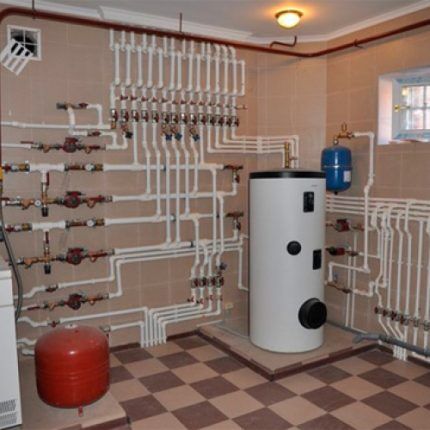
By installing automation, the home owner can adjust the heating process according to his needs. Thanks to this, bills for consumed energy resources will be reduced by 2 times.
Controlling the boiler in automatic mode makes it possible to:
- Turn off the boiler in case of an unusual situation. Carry out automatic start or stop of the boiler in the current mode. Depending on the outside temperature, set the heating temperature.
- Manage heating or water heating branches boiler with 1 combustion chamber.
- Adjust water temperature or other coolant.
- Make adjustments to pump operation circulation or recirculation if the heating system in the house is arranged in a closed circuit. In this case, the system cannot function without automation.
The most important element of the heating system is the thermostat. Its function is to regulate the temperature both in a separate room and in the entire house.
There are many types of thermostats - from simple mechanical to weather-compensated. The latter is the most technologically advanced, profitable, but also very expensive.

The price of automation depends on the type of boiler used, the presence of heated floors, solar collectors, etc. In order not to spend extra money, you should analyze the features of all schemes and calculate the cost. It is quite difficult to do this yourself, but you can always turn to specialists with this problem.
Gas boiler room for your home
Gas is an explosive substance, so the requirements for gas boiler houses are very strict.If a boiler with a power of up to 30 kW is sufficient to heat the house, then there is no need for a separate room for the boiler room.
The boiler can be placed in a well-ventilated kitchen on a wall made of non-combustible materials, provided that the volume of the room is at least 15 m ᶾ, the height from floor to ceiling is from 2.5 m, and the floor area is from 6 m².

All requirements for gas boiler houses are related to preventing the consequences of possible gas leaks. For this purpose, the window area in the room where gas equipment is installed starts from 0.5 m², and the door width from 0.8 m.
The chimney of such a boiler room must rise above the roof ridge by at least 500 cm and have an additional channel for cleaning. Condensate collectors must be installed on the chimney and ventilation.
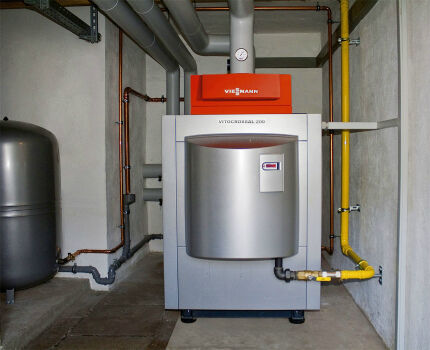
If power gas boiler exceeds 30 kW, it requires a separate building.
The requirements for a separate boiler room are set out in the building codes:
- the foundation of the boiler room building must be separate from the foundation of the house;
- a certain percentage of sand must be present in the concrete solution used in the construction of the building;
- a separate foundation is placed under the boiler, raising it above the finished floor by 0.2 m;
- under the boiler you need a backing made of flat slate or tiles protruding beyond its limits by 0.1 m along the entire perimeter;
- to drain the coolant in case of an emergency, the boiler room must be equipped with a sewerage system;
- within a radius of 0.7 m around the boiler, the space must be free;
- interior decoration must have a fire resistance rating of 0.75 hours.
There are special regulatory requirements for the boiler itself, since it does not belong to the category of household appliances, but to the category of complex engineering equipment. Gas boilers, like all others used in the domestic sector, must have a certificate certifying that they have passed a safety examination.
Control services will never give permission to put into operation a boiler room with a gas boiler if there is no gas detector in the room.
Boiler room with solid fuel boiler
In accordance with the requirements of building codes, solid fuel boilers installed only in non-residential premises. If the power of the unit is large, the construction of a separate boiler room will be required.
What should the room be like?
There are a number of requirements for placement under a solid fuel boiler:
- distance between the firebox door and the wall - from 1.2 to 1.5 m;
- distance from the side walls of the boiler to the wallmade of fireproof material or protected by a special screen - at least 1 m;
- gap between the back wall of the boiler and the surface made of combustible material with a protective screen - at least 0.5 m for boilers with rear connection;
- ban on add-ons above the boiler room;
- efficient supply ventilation, located in the lower part in the form of a gap between the door and the floor or a hole in the wall.
If the wall is made of material that meets fire safety requirements, then it is permissible to attach the pipe located behind the boiler to it using brackets.
In order to operate a CT with parameters of 1x0.8 m at the base with at least a minimum of comfort, you need to install it in a room of 2.8x2.5 m. As the dimensions of the unit increase, the area of the boiler room also increases.

If the boiler room is in the form of an extension, then the correct location for it is a blank wall. The distance to windows and doors in both vertical and horizontal directions must be at least 1 m. If the boiler room is located in the basement, ground floor or first floor, it is necessary to install a door that opens outward.
Equipment for solid fuel boiler house
A functional and well-designed diagram of a boiler room with a solid fuel boiler should include a number of elements:
- Heat generator, equipped with appropriate bunkers, fuel chambers, etc.
- TT boiler piping, consisting of a circulation pump, 3-way valve, safety group.
- Chimney.
- Water heater storage for supplying the house with hot water.
- Automation - weather-dependent or in-house.
- Fire extinguishing system.
Coal, peat, and firewood are used as fuel for TT. The diameter of the chimney in a boiler room with a TT unit must be equal to the cross-section of the boiler pipe. The room requires exhaust ventilation, designed so that for every 8 cm² of its area there is 1 kW of boiler power. If the boiler is installed in the basement, this parameter is multiplied by 3.
A steel sheet must be laid around the base of the boiler. It needs to protrude 1 m on each side. The layer of plaster on the walls should be no less than 3 cm thick.
In the chimney itself, which has the same cross-section along its entire length, holes are provided for collecting and removing soot. A mandatory attribute is fire extinguishing equipment.
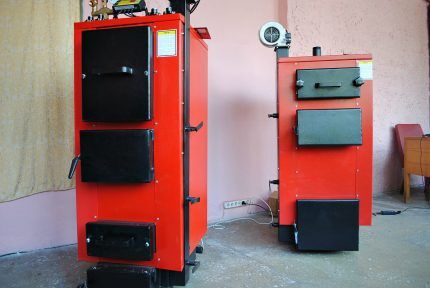
For 1 kW of TT boiler power there should be about 0.08 m² of glazing area. The maximum permissible area of the boiler room is 8 m². If you plan to load the firebox with coal, then the electrical wiring must be protected from coal dust, because it can explode at a certain concentration.
Advantages of a liquid fuel boiler
Install oil boiler much simpler than its gas or solid fuel counterpart. You can place it in the house and in the yard.
The main advantage is the absence of the need for approval and obtaining permits. All that is required from the owner of the house is to provide free access for a car with fuel and regularly refuel the boiler.
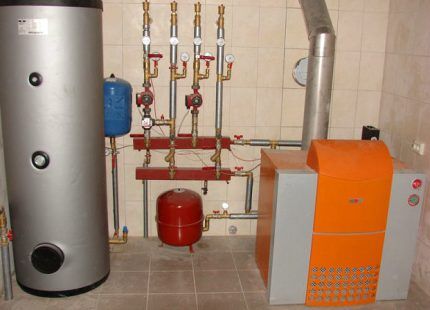
To obtain 10 kW of power, about 1 liter of diesel fuel is consumed, but the exact consumption depends on the quality of the fuel. In the middle zone, with a house area of 200 m², about 5 thousand liters of fuel will be required for the heating season. The chimney must be cleaned periodically.
To install a diesel boiler, an average of 4 m² is required. If supply ventilation is provided by air flow from other rooms of the house, then per 1 kW of boiler power there should be at least 30 cmᶾ of air.With external ventilation this figure decreases to 8 cmᶾ.
Electric boiler for a private boiler room
Of all the models used in a private home, the safest is electric boiler. It is not necessary to equip a separate boiler room for it. When heating the coolant, no combustion products are released, so ventilation is not needed for it.
Installation of such boilers is simple, they do not create noise during operation, and they are easy to care for. Electric boilers have high efficiency, reaching 99% in some cases. The disadvantage is the high requirements for network power, as well as the dependence on its stable operation.

The connection of an electric boiler is carried out according to different schemes: it is connected to heating radiators, and the possibility of installing a cascade is provided in cases where it is necessary to heat a large area.
The piping is carried out according to two schemes - direct and mixing. In the first case, the temperature is controlled using a burner, and in the second, using a servo-driven mixer.
Conclusions and useful video on the topic
Information about an autonomous boiler house in an accessible form, even for a person far from this topic:
If you are at the stage of choosing boiler equipment, you will find the information presented in this video useful:
Video with a detailed diagram of a boiler room with a solid fuel boiler:
The latest developments by companies producing boiler equipment are aimed at reducing energy consumption through low-temperature programs.
The main role in the matter of saving is automation, which allows you to select optimal modes and regulate the temperature so that the heating level is reduced without compromising overall comfort. These nuances must be taken into account when drawing up a boiler room diagram for your home.
If you have experience in arranging a boiler room in a private home, please share the information with our readers. Leave comments and ask questions on the topic in the form below.




It is better to make a boiler room on the ground floor. We have it in the back of the house. They even made a separate entrance for it. I didn’t want to, if there was an equipment check, or God forbid I had to repair the boiler, strangers were wandering around the house. If you equip a basement for this purpose, then due to the operation of the equipment, and in this case it will always be quite hot there, there can be no talk of any use of the remaining space for storage and food storage.
What are the advantages of a boiler room on the ground floor? And what are you planning to store in the basement? When the boiler room is in the basement, fuel can be stored right there.
Most likely, a person has slightly distant ideas about the arrangement of a boiler room. Firstly, no one will do it in the basement (cellar), where supplies for the winter are stored! A boiler room in the basement can be installed if it is a full basement, for example.
The most profitable option is an extension or a separate structure, and not a boiler room on the ground floor of the building. Here are some objective reasons:
— saving space;
— ease of installation of ventilation and other communications;
- safety.
If the boiler room is located on the ground floor of the building that it heats, then it “eats up” the usable area. An extension or a separate structure are the best options, both from a practical point of view and from a financial one. You can also organize a boiler room in the basement, but this needs to be included immediately in the house design.
Hello! Should the boiler room be of a certain volume or area?
Good afternoon. Boiler room area. The official requirements for a boiler room in a private house in 2021 state that the minimum volume of the facility must be 15 cubic meters. That is, the furnace room is allowed to be placed in built-in, attached or free-standing objects with an area of 5 m2. In most cases, this is not enough, so professionals recommend setting aside larger rooms for heating equipment. Dimensions of a boiler room in a private house.
How to correctly calculate the volume of a boiler room if there is a flight of stairs to the basement in its room? We consider the volume of a room located entirely on one level of the first floor. Or the volume of the boiler room must be calculated within a closed contour with cut-off doors. That is, a boiler room + a basement room. If the boiler room runs on methane, then it is a light gas; it will not go into the basement unless, of course, it creates a good excess pressure. There is no clarification on this anywhere.